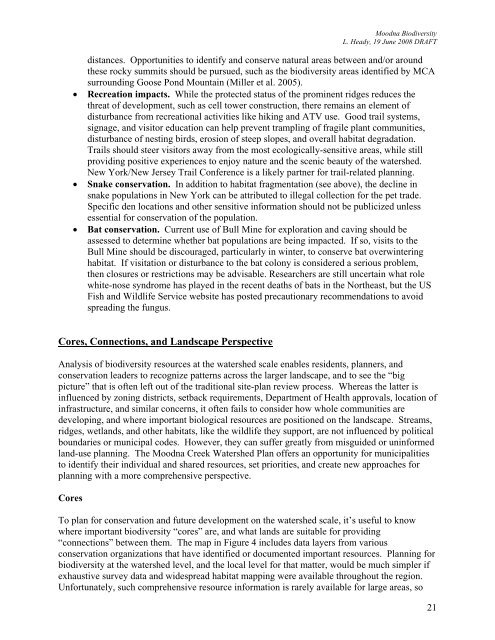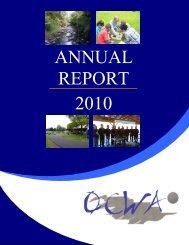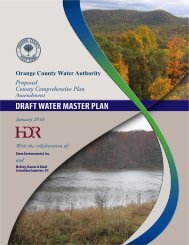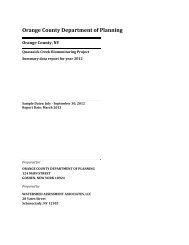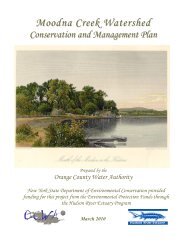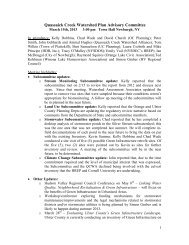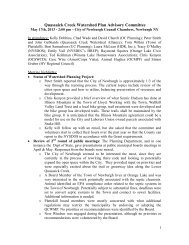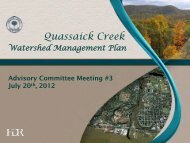Biodiversity of the Moodna Creek Watershed - Orange County Water ...
Biodiversity of the Moodna Creek Watershed - Orange County Water ...
Biodiversity of the Moodna Creek Watershed - Orange County Water ...
You also want an ePaper? Increase the reach of your titles
YUMPU automatically turns print PDFs into web optimized ePapers that Google loves.
<strong>Moodna</strong> <strong>Biodiversity</strong><br />
L. Heady, 19 June 2008 DRAFT<br />
distances. Opportunities to identify and conserve natural areas between and/or around<br />
<strong>the</strong>se rocky summits should be pursued, such as <strong>the</strong> biodiversity areas identified by MCA<br />
surrounding Goose Pond Mountain (Miller et al. 2005).<br />
• Recreation impacts. While <strong>the</strong> protected status <strong>of</strong> <strong>the</strong> prominent ridges reduces <strong>the</strong><br />
threat <strong>of</strong> development, such as cell tower construction, <strong>the</strong>re remains an element <strong>of</strong><br />
disturbance from recreational activities like hiking and ATV use. Good trail systems,<br />
signage, and visitor education can help prevent trampling <strong>of</strong> fragile plant communities,<br />
disturbance <strong>of</strong> nesting birds, erosion <strong>of</strong> steep slopes, and overall habitat degradation.<br />
Trails should steer visitors away from <strong>the</strong> most ecologically-sensitive areas, while still<br />
providing positive experiences to enjoy nature and <strong>the</strong> scenic beauty <strong>of</strong> <strong>the</strong> watershed.<br />
New York/New Jersey Trail Conference is a likely partner for trail-related planning.<br />
• Snake conservation. In addition to habitat fragmentation (see above), <strong>the</strong> decline in<br />
snake populations in New York can be attributed to illegal collection for <strong>the</strong> pet trade.<br />
Specific den locations and o<strong>the</strong>r sensitive information should not be publicized unless<br />
essential for conservation <strong>of</strong> <strong>the</strong> population.<br />
• Bat conservation. Current use <strong>of</strong> Bull Mine for exploration and caving should be<br />
assessed to determine whe<strong>the</strong>r bat populations are being impacted. If so, visits to <strong>the</strong><br />
Bull Mine should be discouraged, particularly in winter, to conserve bat overwintering<br />
habitat. If visitation or disturbance to <strong>the</strong> bat colony is considered a serious problem,<br />
<strong>the</strong>n closures or restrictions may be advisable. Researchers are still uncertain what role<br />
white-nose syndrome has played in <strong>the</strong> recent deaths <strong>of</strong> bats in <strong>the</strong> Nor<strong>the</strong>ast, but <strong>the</strong> US<br />
Fish and Wildlife Service website has posted precautionary recommendations to avoid<br />
spreading <strong>the</strong> fungus.<br />
Cores, Connections, and Landscape Perspective<br />
Analysis <strong>of</strong> biodiversity resources at <strong>the</strong> watershed scale enables residents, planners, and<br />
conservation leaders to recognize patterns across <strong>the</strong> larger landscape, and to see <strong>the</strong> “big<br />
picture” that is <strong>of</strong>ten left out <strong>of</strong> <strong>the</strong> traditional site-plan review process. Whereas <strong>the</strong> latter is<br />
influenced by zoning districts, setback requirements, Department <strong>of</strong> Health approvals, location <strong>of</strong><br />
infrastructure, and similar concerns, it <strong>of</strong>ten fails to consider how whole communities are<br />
developing, and where important biological resources are positioned on <strong>the</strong> landscape. Streams,<br />
ridges, wetlands, and o<strong>the</strong>r habitats, like <strong>the</strong> wildlife <strong>the</strong>y support, are not influenced by political<br />
boundaries or municipal codes. However, <strong>the</strong>y can suffer greatly from misguided or uninformed<br />
land-use planning. The <strong>Moodna</strong> <strong>Creek</strong> <strong><strong>Water</strong>shed</strong> Plan <strong>of</strong>fers an opportunity for municipalities<br />
to identify <strong>the</strong>ir individual and shared resources, set priorities, and create new approaches for<br />
planning with a more comprehensive perspective.<br />
Cores<br />
To plan for conservation and future development on <strong>the</strong> watershed scale, it’s useful to know<br />
where important biodiversity “cores” are, and what lands are suitable for providing<br />
“connections” between <strong>the</strong>m. The map in Figure 4 includes data layers from various<br />
conservation organizations that have identified or documented important resources. Planning for<br />
biodiversity at <strong>the</strong> watershed level, and <strong>the</strong> local level for that matter, would be much simpler if<br />
exhaustive survey data and widespread habitat mapping were available throughout <strong>the</strong> region.<br />
Unfortunately, such comprehensive resource information is rarely available for large areas, so<br />
21


